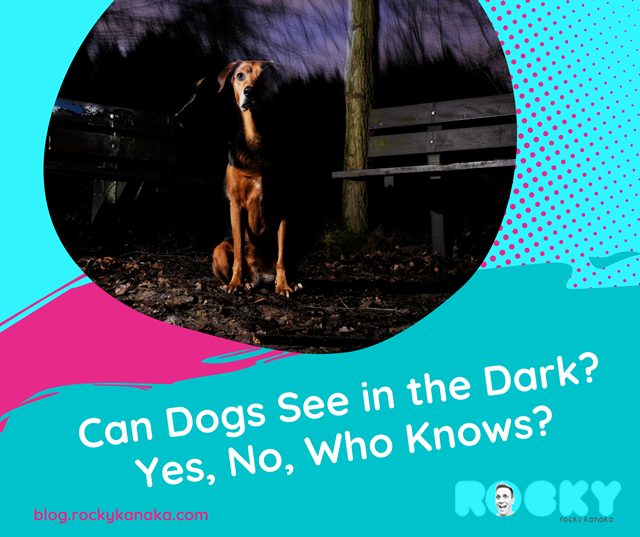Can Dogs See in the Dark? Yes, No, Who Knows?
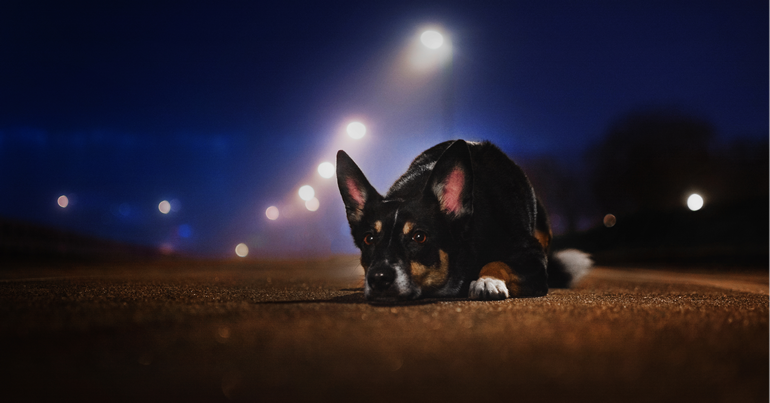
Yes. Dogs have night vision. In fact, it’s commonly believed that dogs can see in the dark five times better than we can.
Why is night vision possible for dogs and not in humans?
The answer lies in the construction of the canine eye, which they inherited from their wolf ancestor. Even after evolving into daytime creatures, dogs have retained eyesight that’s well-adapted to dim light.
So, without further ado, let’s get into the science behind everything that’s dark, dim, and shadowy to a dog’s eye.
Eye Structures Making Night Vision Possible
The canine eye has three adaptations that allows dogs to see five times more in the dark than humans:
1. A Reflective Tapetal Surface
Dogs have a tapetum lucidum, meaning carpet of light, that makes nighttime look like daytime. The tapetum lies between the retina and choroid where it reflects light to the retina and rods, redoubling the light available for perception.
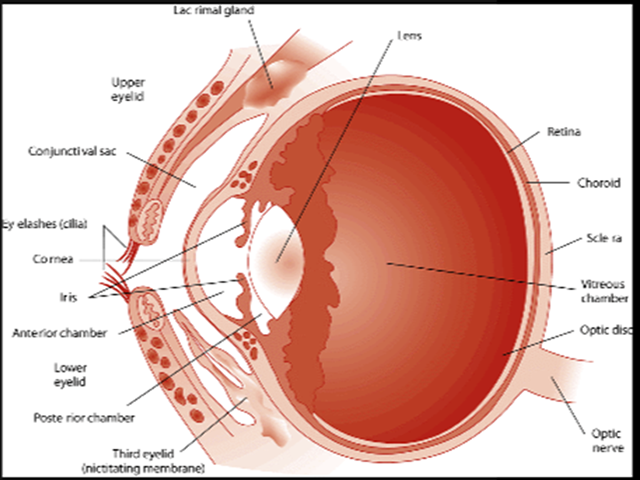
The tapetum lucidum also makes the light that bounces back fluoresce, or shine, more. As light intensity increases, the wavelength also changes, resulting in a transformed light that rods can perceive and detect better.
Disadvantages of Having a Tapetal Surface
A healthy human eye has a 20:20 visual acuity, meaning we can see the ‘expected’ details of an object that’s 20 feet away.
In dogs, this visual acuity degrades to 20:75 due to the tapetum lucidum, which scatters light in the process of reflecting it to the retina for reprocessing. Therefore, dogs will see objects 20 feet away as a human would see them from a distance of 75 feet.
A lower visual acuity means a dog’s vision isn’t as detailed as ours. This is why some dogs struggle to find objects in their direct line of view.
This isn’t something to worry about, however.
For dogs, eyes play more of an accessory role than other senses. Whereas we primarily rely on our eyes for identification, canines rely on their noses.
For example, in the video below, my wife and I introduce a robot dog to our dogs, including our blind dog, Kobe. We thought bonding would be easy because this robot looked and acted like a real dog. However, our dogs’ butt-sniffing identification mechanisms proved our robot wasn’t doggy enough for them.
The next time a dog turns the eyes in your direction, don’t assume they’re looking at you. They’ve probably turned to give their snout a better perspective. The eyes are probably just there for the ride.
The Tapetal Surface Accounts for the Eye Glow
The reflective tapetum lucidum is also responsible for the reflection, or “eye glow,” that’s sometimes noticeable in the dark or in photos. When light enters the eye, the tapetal surface reflects it to the retina, giving dogs an eyeshine.
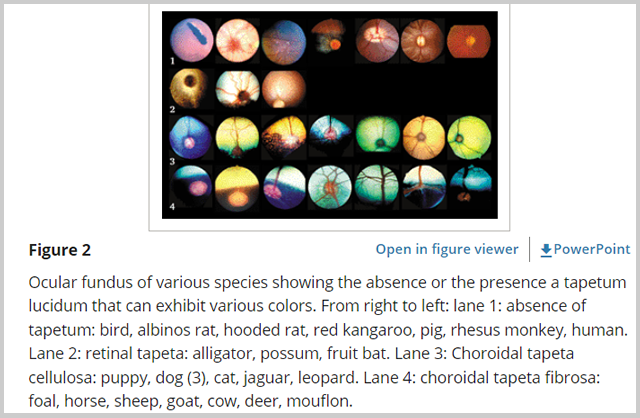
The tapetal luminesce in dogs varies by:
- Breed. It can range from blue to yellow, green, or orange hues. For example, black labs often have a green tapetal reflection, buff Cocker Spaniels have a yellow one, and young puppies often have a blue glow until their tapetum lucidum matures.
- Body size. The tapetal size is also size dependent. For instance, Miniature Schnauzers have a smaller tapetum than larger dogs like Golden Retrievers.
- Amount of zinc and riboflavin in the tapetum. These reflective minerals affect both glow color and luminesce. The higher their concentration, the greater the glow.
- Age. As dogs age, the lens becomes denser, reducing the reflective properties of the eyes. Glow color can also change as a puppy grows.
- Eye color. It’s common for blue-eyed dogs to have a red glow. This red-eye effect comes from their blood vessels, as these breeds often lack a tapetum.
2. Rod-Dominant Retina
A dog’s retina is rod-dominant, including in “area centralis” where cones should dominate for vision acuity. This distribution of rods throughout a dog’s eye increases the surface area for light processing and image development.
Rods work best in low light because they only need a few photons to activate. This makes them ideal for night vision.
Additionally, they are sensitive to changes in light, which occurs when an object is in motion. As such, rods are better suited to detect motion, particularly in low light.
The other photoreceptors telling the brain what a dog sees are the cones. These cones allow for sensitivity to bright light and color. They also allow for high visual acuity in order to perceive the details of an object.
The table below highlights the differences between rods and cones.
| Rods | Cones |
| Low acuity (blurry vision) | High acuity (detailed vision) |
| Activated in low light | Activated in bright light |
| No color sensitive molecules | Has color detecting molecules (sees blue and yellow) |
| High sensitivity to motion | High sensitivity to details |
| Most dominant | Fewer than rods |
How many rods do dogs have?
The exact number of rods in a dog’s eye remains unknown. However, researchers estimate that cones constitute about 3% of the retina cells and 20% of all receptors in the area centralis, where visual acuity is highest.
It’s also been established that a dog’s cones allow for dichromatic sight. As such, dogs can only distinguish blue and yellow, and shades of gray. By contrast, humans have trichromatic vision because our cones can process red, green, and blue colors.

Can dogs see color at night?
Since cones need a lot of light to function, they are hardly activated at night. Therefore, it’s possible that under dim light, a dog sees the world in black and white or shades of gray.
3. Large Pupils
Dogs have larger pupils than humans, meaning that more light can enter the eye for image development.
At night, or in situations of light scarcity, this is an advantage. Under such circumstances, the iris dilator muscle makes the pupils bigger, allowing in more light.
Dogs See ‘More’ World than Humans
The field of view in dogs is breed-dependent. The more centrally located the eyes, the better the binocular view and depth of images. Similarly, the more laterally placed the eyes, the lower the binocular view—about 60°—but the more expansive the sight.
The lateral placement widens the monocular view of one eye to 150° and the total field of view to 240°–270°. It’s this broadened view of the world that allows your dog to detect motion, bark at, and chase objects oblivious to your eye.
Humans, on the other hand, have forward-placed eyes, and the nose barely interferes with the detailed view of an object. Our binocular view of about 140° enhances depth of the viewed image. We also have a 180° range of view, with a blurry periphery.
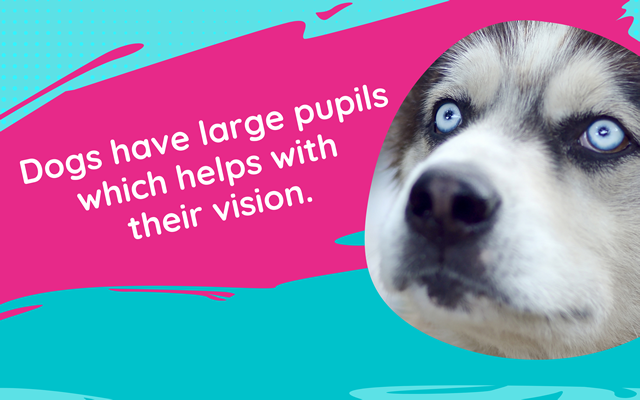
Why You Should Care About Your Dog’s Vision
Like humans, dogs can get eye diseases, and can even go blind. These issues can adversely affect your dog’s quality of life as well as your peace of mind.
Knowing what a dog’s night vision and eyes look like can help you decide whether your dog needs medical attention.
Additionally, sight is an important consideration when buying or adopting a dog. For example, living with a blind dog, like Kobe in the video below, is different from having a pet with no sight issues. He is a happy special needs dog.
Therefore, ask as many sight questions as possible before adopting a dog so you really understand what you’re getting into.
Frequently Asked Questions
What’s the difference between a dog’s and a human’s vision?
The table below summarizes the main differences between dog and human vision:
| Factor | Dog-Eyed | Human-Eyed |
| Daytime vision | 20:75 vision acuity in many healthy dogs | 20:20 vision acuity in healthy people |
| Night vision | Clearer due to larger pupils, more rods than cones, and tapetum lucidum | Less clear due to fewer rods and no tapetum lucidum |
| Flickering light sensitivity | Up to 80Hz due to more rods than cones; sees movies as flickers more than continuous storylines | Up to 60Hz in some people; allows for fluidity when watching TV |
| Visual perspective | Reduced due to height from the ground | Higher due to height from the ground |
| Field of view | Up to 270° due to laterally located eyes
Allows dogs to scan the environment better |
Up to 180° due to forward placed eyes
Objects get blurry towards the periphery |
| Color | Sees the world in shades of blue, yellow, and gray due to dichromatic vision | Sees colorful worlds due to trichromatic vision made possible by cones |
Do dogs see color at night?
It depends on the amount of light present. If it’s enough to activate the cones, then your dog will see color. If not, it’s likely that dogs will see the world in black and white.
My dog’s eyes have a red glow. Is he sick?
Not likely. The presence and color of the tapetum lucidum are breed- and age-dependent. Breeds without a tapetal surface give off a red glow.
Can my dog go blind?
Yes. Dogs are also susceptible to eye diseases and blindness. If you suspect something is wrong with your dog, consider seeking medical attention. Want to know more? Read this article about blindness in dogs.
Are a dog’s pupils the same size?
Yes. If you notice any differences, seek medical attention as soon as possible.
What toy colors will make my dog happiest?
Dogs can only differentiate between yellow and blue. A blue or yellow toy is attractive to your dog.
About Rocky Kanaka
I’m a pet rescue advocate, Emmy-nominated host and creator of my own show. My passion is sharing stories about rescue dogs, pet adoption, fostering, and volunteering because I believe that every dog deserves a loving home.
I’m a dog dad to a rescued boxer named Flip, a blind Cane Corso called Kobe, and a senior terrier-mix named Zoey, along with the many foster dogs I help on their way to their forever home.
Enjoy magical transformations, heart-warming rescues and meeting unique people and their incredible dogs via YouTube, Facebook, Instagram.
Share on Facebook:

